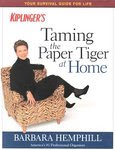
Every January, I get bitten by the organizing bug. After the excesses that can come with the Christmas season (More lights! More fudge! More toys!) I find that January is a great time to pare down and simplify. I know that I'm not alone in my January urge to organize. Witness the massive sales on giant storage bins, plastic shoe boxes, and shelving at the box stores. If January inspires you to organize too, I've got some organizing-themed posts up my sleeve that I'm looking forward to sharing with you as we start a new year.
But first things first. When was the last time you cleaned out your junk drawer? If it's been awhile, you might consider trying it--for the comedic value if for nothing else. I'm not kidding; it's a hoot. You won't believe what you've got in there. You complain that you can never find a pen that works, but do you
know how many functional writing instruments you have in that drawer? Seventeen.
Seventeen. Well, that's how many I found when I recently cleaned out our junk drawer! I also discovered:
*A slinky
*An ancient "Happy Birthday" streamer
*Garden clippers, dog nail clippers, and a Swiss army knife
*A tiny pink plastic cat
*Part of a microphone
*The guts of an electronic baby toy that used to honk like a car (
Hmmm, wonder how
that toy "broke"?)
*Two guitar picks, strawberry
Chapstic, and a poker chip
*A dryer hose clamp
*The keys to the homes of 4 friends, neighbors, and relatives
*A love note that my husband hid in my coat pocket when we were first dating
*The tag from the first batch of Roma tomatoes that we planted in our garden.
*And one lousy penny.
One. Aren't you supposed to find gobs of money when you clean out the junk drawer?
The most amusing thing that I found was a bottle opener engraved with the words "Swiped from L & L Bar,
Woodburn, Ind.". This is funny because
1. We're not really bar people
2. We don't swipe things
3. We've never been to the L & L Bar
4. We've never even been to
Woodburn, Indiana
5. According to Google, the L & L Bar doesn't even exist
See what I mean? Cleaning out the junk drawer is a blast. It's a great way to celebrate the start of a new year. Way cooler than partying with a lampshade on your head, if you ask me.
Feeling inspired? Cleaning out your junk drawer is a manageable project that should only take fifteen minutes of your time. A great way to tackle a finite organizing task like this is to use Julie
Morgenstern's acronym S.P.A.C.E., which stands for: "Sort", "Purge", "Assign a Home", "Containerize", "Equalize". Applied to this project, it would look like this:
1.
Sort: Take everything out of the drawer and
sort items into categories. For example, put all of the writing instruments together, all of the tools together, all of the coupons together, etc.
2.
Purge: Within each category, decide what you can
purge (get rid of). "No
brainers" would include dried up pens and expired coupons, but you may find (thanks to the
sort step) that you have enough multiples of other items to throw away or give away the extras. Really, do you
need fifty-seven bread tabs?
3.
Assign a Home: Look at each item (or category of items) and decide where that item should "live". Can that extra flashlight be moved to the car? Can those reading glasses be moved to the end table by your favorite reading chair?
4.
Containerize: Consider placing some of the items in
containers within the drawer to help keep the drawer neat. Select containers only after you've completed the earlier steps so you know how large each container needs to be. In our drawer, I used a narrow, shallow cardboard box to corral writing instruments and another small cardboard box to hold all of the keys.
5.
Equalize: Maintain your newly-organized space by periodically assessing how it's working and clearing it out again if necessary.
So what's in
your junk drawer? If you want to start the new year with a
de-junked junk drawer, go ahead and clean it out and then come back here to share what you found in the comments below.
Here's to a nice fresh start to a great new year!
This post has been linked to DIY Day at
A Soft Place to Land.
 Blogger's note: This post was originally published in January of 2010, and was updated in October of 2020.
Blogger's note: This post was originally published in January of 2010, and was updated in October of 2020.

 I love these bags. They're sturdy, affordable, easy to carry with one hand, and each bag holds a full load of laundry. The hook at the top of the bag comes in handy for hanging the bag when you're transferring clothes into the washing machine.
I love these bags. They're sturdy, affordable, easy to carry with one hand, and each bag holds a full load of laundry. The hook at the top of the bag comes in handy for hanging the bag when you're transferring clothes into the washing machine.















